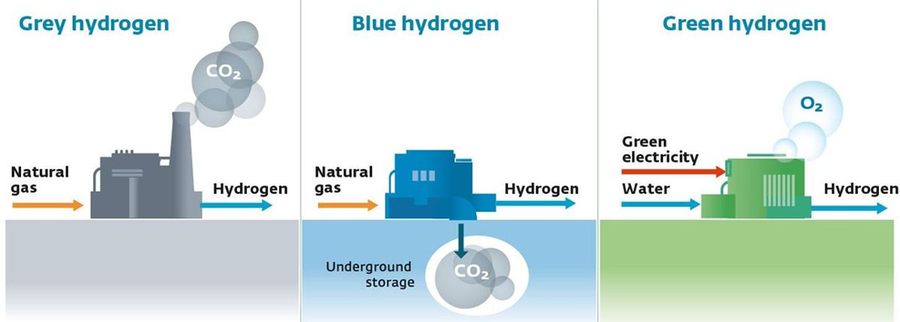In News:
- India will emerge as the leader of green hydrogen, Minister of Petroleum and Natural Gas Hardeep Singh Puri recently made the remarks while attending the World Economic Forum at Davos, Switzerland.
What’s in today’s article:
- About Hydrogen (Properties, abundance)
- Types of Hydrogen (Grey, Blue, Green)
- About Green hydrogen (Benefits, India’s goals, Challenges, etc.)
About Hydrogen:
- Hydrogen is the lightest chemical element.
- It is colourless, odourless, tasteless, non-toxic, and highly combustible.
- It is the 3rd most abundant element in the human body.
- The two most abundant elements in human body are Oxygen and Carbon.
- Hydrogen is the most abundant chemical substance in the universe, constituting roughly 75% of all normal matter.
- Hydrogen can be produced from a range of resources including fossil fuels, nuclear energy, biomass and renewable energy sources.
Types of Hydrogen:

- Depending on production methods, hydrogen can be Grey, Blue or Green.
- Grey Hydrogen:
- Grey hydrogen is created from natural gas, or methane, using Steam Methane Reformation (SMR) but without capturing the greenhouse gases made in the process.
- In SMR, high-temperature steam (700°C–1,000°C) is used to produce hydrogen from a methane source, such as natural gas.
- The CO2 produced in this process is released directly into the atmosphere.
- Unfortunately this accounts from roughly 95% of the hydrogen produced in the world today.
- Blue Hydrogen:
- Hydrogen is labelled blue whenever the carbon generated from steam reforming is captured and stored underground through industrial carbon capture and storage (CSS).
- Blue hydrogen is, therefore, sometimes referred to as carbon neutral as the emissions are not dispersed in the atmosphere.
- However, some argue that “low carbon” would be a more accurate description, as 10-20% of the generated carbon cannot be captured.
- It has significant cost and emissions advantages.
- Green Hydrogen:
- Green hydrogen is produced by using clean energy from surplus renewable energy sources, such as solar or wind power, to split water into two hydrogen atoms and one oxygen atom through a process called electrolysis.
- This makes green hydrogen the cleanest option – hydrogen from renewable energy sources without CO2 as a by-product.
- It currently makes up about 0.1% of overall hydrogen production, but this is expected to rise as the cost of renewable energy continues to fall.
India’s Green Hydrogen Production goals w.r.t. other countries:
- In August 2021, Prime Minister Narendra Modi announced the National Hydrogen Mission as a step towards environmental security and make India a global hub for the production and export of green hydrogen.
- India plans to manufacture 5 million tonnes of green hydrogen per year by 2030.
- This would be half of the European Union’s 2030 target of 10 million tonnes.
- On the other hand, China announced a relatively shorter-term target to produce up to 2,00,000 tonnes per year of green hydrogen by 2025.
- Spain, Germany and France have announced their commitment to install 4 GW, 5GW and 6.5 GW of green hydrogen respectively, by 2030.
Present Capacity:
- There are 26 hydrogen projects in India, with a total capacity of 255,000 tonnes per year.
- However, a majority of these announced projects are still in their early stages.
- Only around 8,000 tonnes per year of capacity is expected to be operational by 2024.
Challenges associated with Green Hydrogen:
- Technology:
- Electrolysis is the process of using electricity to split water into hydrogen and oxygen.
- By running an electrical current through water, the membrane and electrolyte can separate the water into hydrogen and oxygen.
- Green hydrogen needs electrolysers to be built on a scale larger than we've yet seen.
- Transportation & Storage:
- Either very high pressures or very high temperatures are required, both with their own technical difficulties.
- Electricity:
- Creating green hydrogen needs a huge amount of electricity, which means an exponential increase in the amount of wind and solar power to meet global targets.









